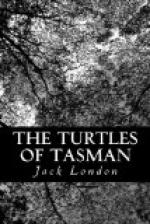But the man was undisturbed. His head had slipped from the folded newspaper, and the straggling unkempt hair was matted with the foxtails and burrs of the dry grass on which it lay. He was not a pretty sight. His mouth was open, disclosing a gap in the upper row where several teeth at some time had been knocked out. He breathed stertorously, at times grunting and moaning with the pain of his sleep. Also, he was very restless, tossing his arms about, making jerky, half-convulsive movements, and at times rolling his head from side to side in the burrs. This restlessness seemed occasioned partly by some internal discomfort, and partly by the sun that streamed down on his face and by the flies that buzzed and lighted and crawled upon the nose and cheeks and eyelids. There was no other place for them to crawl, for the rest of the face was covered with matted beard, slightly grizzled, but greatly dirt-stained and weather-discoloured.
The cheek-bones were blotched with the blood congested by the debauch that was evidently being slept off. This, too, accounted for the persistence with which the flies clustered around the mouth, lured by the alcohol-laden exhalations. He was a powerfully built man, thick-necked, broad-shouldered, with sinewy wrists and toil-distorted hands. Yet the distortion was not due to recent toil, nor were the callouses other than ancient that showed under the dirt of the one palm upturned. From time to time this hand clenched tightly and spasmodically into a fist, large, heavy-boned and wicked-looking.
The man lay in the dry grass of a tiny glade that ran down to the tree-fringed bank of the stream. On either side of the glade was a fence, of the old stake-and-rider type, though little of it was to be seen, so thickly was it overgrown by wild blackberry bushes, scrubby oaks and young madrono trees. In the rear, a gate through a low paling fence led to a snug, squat bungalow, built in the California Spanish style and seeming to have been compounded directly from the landscape of which it was so justly a part. Neat and trim and modestly sweet was the bungalow, redolent of comfort and repose, telling with quiet certitude of some one that knew, and that had sought and found.
Through the gate and into the glade came as dainty a little maiden as ever stepped out of an illustration made especially to show how dainty little maidens may be. Eight years she might have been, and, possibly, a trifle more, or less. Her little waist and little black-stockinged calves showed how delicately fragile she was; but the fragility was of mould only. There was no hint of anaemia in the clear, healthy complexion nor in the quick, tripping step. She was a little, delicious blond, with hair spun of gossamer gold and wide blue eyes that were but slightly veiled by the long lashes. Her expression was of sweetness and happiness; it belonged by right to any face that sheltered in the bungalow.
She carried a child’s parasol, which she was careful not to tear against the scrubby branches and bramble bushes as she sought for wild poppies along the edge of the fence. They were late poppies, a third generation, which had been unable to resist the call of the warm October sun.




